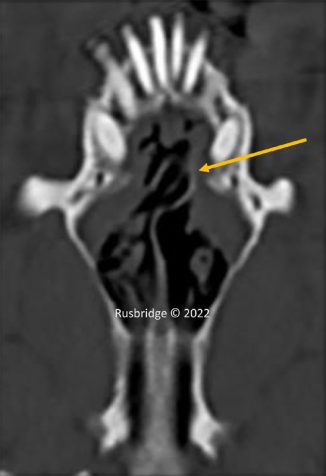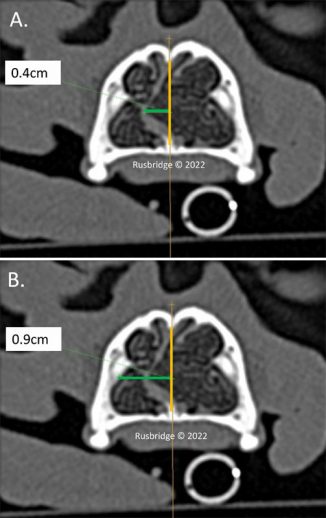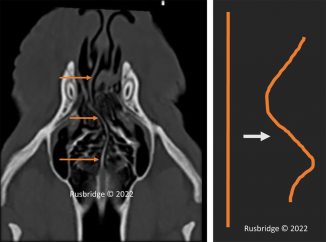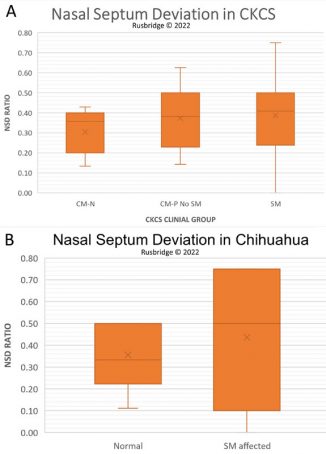Nasal Septum Deviation in dog breeds predisposed to Chiari-like Malformation associated pain and Syringomyelia – Prof. Clare Rusbridge
 The dog has two nostrils (nares) divided by a cartilaginous and bony septum (divides the nasal cavity).
The dog has two nostrils (nares) divided by a cartilaginous and bony septum (divides the nasal cavity).
When a dog flares its nostrils to sniff, the shape of the nostril openings change allowing redirection of air into the upper part of the snout and more direct airflow to the olfactory area (sense of smell area). The slit at the side of the nares is used in the expiration of breath during sniffing. The air is breathed in through the nostrils into the back of the nose and on into the lungs.
When the septum is displaced to one side the nasal air passages are narrowed, reducing airflow which causes difficulty in breathing. If severe or combined with other features then obstructive airway syndrome may result.
This study investigates the correlation between the presence and extent of NSD (Nasal Septum Deviation ) and CM/SM (Syringomyelia).
Cavalier Matters funded the majority of the CT scans for the Cavalier King Charles Spaniels for this research.
Introduction

- Chiari-like malformation (CM) is a developmental condition, characterised by a conformational change and overcrowding of the brain and spinal cord with obstruction of CSF channels. CM frequently results in pain (CM-associated pain; CM-P) and fluid cavitation of the spinal cord (syringomyelia; SM).
- Nasal septum deviation (NSD), in which the nasal septum is displaced to one side, reduces the size of one nasal air passage. If severe or combined with other features such as hypertrophic and aberrant nasal turbinates then obstructive airway syndrome may result (Figure 1)NSD, CM, CM-P and SM are common in flat-faced brachycephalic dogs.
- NSD may be clinically irrelevant1 but has been associated with sleep disordered breathing (SDB) in dogs2 and humans.3
- SDB affects glymphatic drainage of cerebrospinal fluid which could predispose CM-P and SM.4 In a previous publication – 3 of 5 SDB affected cavalier King Charles spaniels (CKCS) with NSD had confirmed or suspected SM.2
- SBD is a serious welfare concern especially if in conjunction with other comorbidities which cause pain and sleep disturbance
- This study investigated correlation between presence and extent of NSD and CM and SM.
Hypothesis
- Brachycephalic dogs with clinically relevant Chiari-like malformation and syringomyelia more likely to have nasal septum deviation compared to normal dogs.
- Dogs with CM-P and SM have more severe NSD than dogs of the same breed without CM-P and SM.
Methods

Study population – 76 dogs with head CT (Ethics Approval: NASPA-1819-10) and known CMSM status (based on MRI and medical history). Comprising 53 CKCS (7 CM-N i.e. MRI determined breed-associated CM but clinically normal;14 with CM-P but no SM; 32 with SM); 12 Chihuahua (5 MRI and clinically normal, 7 with SM); 11 other brachycephalic toy dog breeds and crosses (10 with SM). Transverse CT of the nasal cavity in bone windows was reviewed. Presence of NSD was recorded. A previously described1 method of determining the NSD angle was attempted but was not reproducible and was abandoned. A new method – the NSD ratio was calculated (maximum distance of NSD from midline divided by distance from midline to nasal cavity wall (Figure 2).
Data analysis included descriptive statistics. For the CKCS, One-Way ANOVA compared the CM-N, CM-Pain and SM groups. A Tukey test was used post-hoc to examine pair-wise group comparisons. For Chihuahua, a Welch’s t-test was used to compare normal and SM affected groups. Statistical comparison between the “other breed” group (comprising 4 Pomeranian, 3 Griffon Bruxellois, 1 Pug, 1 Affenpinscher, 1 Cavapoo and 1 Chihuahua x Pug) was not possible because of low numbers.
Results

- The 1st hypothesis was not proved. NSD was almost ubiquitous in the study population; Only 3 of 63 dogs had a midline nasal septum and symmetrical nasal cavities (1 Chihuahua, 1 CKCS, 1 Cavapoo; all SM affected).
- The nasal deviation was often “S” shaped in a dorsal plane (Figure 3) as if the septum was “predetermined” to be longer but must conform to a shorter space.
- The 2nd hypothesis was not proven. There was no correlation between NSD ratio and CM-P or SM.
- One-Way ANOVA for CKCS groups p= 0.469.
- Tukey multiple comparisons of mean (95% confidence) did not find a significant difference between CKCS groups.
| Comparison | p value |
|---|---|
| CM-N versus CM-P | 0.625 |
| CM-N versus SM | 0.435 |
| CM-P versus SM | 0.960 |
- Welch’s t-test for Chihuahua groups p= 0.555
- Study was limited by being underpowered

Impact
- NSD is common in dog breeds predisposed to CMSM. Care should be taken before attributing clinical relevance.
- Association of NSD to CMSM is unproven. More extreme brachycephaly is associated with both NSD, CM-P and SM and therefore the conditions may co-exist.
- Airway obstruction, SDB and apnoea may be relevant in the pathogenesis of CMSM or be an important comorbidity. More sophisticated methods of investigation are recommended for example polysomnography to monitor respiratory effort.
Acknowledgements
This project was inspired by a CRA at 61st BSAVA Annual Congress (T. Hinchliffe)2 and conversation with Dr Jane Ladlow – thanks to BSAVA for enabling these forums encouraging scientific discussion and collaboration. Cavalier Matters Charity funded the CT of the majority of the CKCS. The cost of the CT was substantially reduced by Fitzpatrick Referrals thus making this research possible in the first place.
References
- Miles S, Schwarz T. Canine nasal septum deviation can be a normal variation and correlates with increasing skull indices. Vet Radiol Ultrasound. 2020 May;61(3):279-284. doi: 10.1111/vru.12846. Epub 2020 Jan 29. PMID: 31994816.
- Hinchliffe TA, Liu NC, Ladlow J. Sleep-disordered breathing in the Cavalier King Charles spaniel: A case series. Vet Surg. 2019 May;48(4):497-504. doi: 10.1111/vsu.13148. Epub 2018 Dec 28. PMID: 30592314.
- Kara M, Erdoğan H, Güçlü O, Sahin H, Dereköy FS. Evaluation of Sleep Quality in Patients With Nasal Septal Deviation via the Pittsburgh Sleep Quality Index. J Craniofac Surg. 2016 Oct;27(7):1738-1740. doi: 10.1097/SCS.0000000000003008. PMID: 27536915.
- Rusbridge C, Knowler P. The Need for Head Space: Brachycephaly and Cerebrospinal Fluid Disorders. Life. 2021; 11(2):139. https://doi.org/10.3390/life11020139

